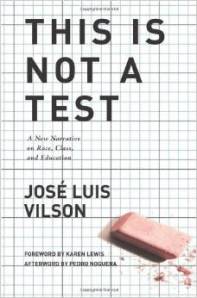Jose Vilson’s blog is a must read for anyone who follows and cares about public schools in the U.S. It’s a smart take on education policy and politics with a strong focus on the crucial issues of race and poverty.
His new book, “This Is Not a Test: A New Narrative on Race, Class and Education,” is even better – an open-hearted account of the joys and frustrations of teaching in an era of polarizing disputes about how to improve schools. With teachers, especially teachers of color, too often voiceless, the book fills a big gap in the conversation.
 But readers looking for a political tract or a detailed expose of reformist errors won’t find it here. Neither is it a slog through the pros and cons of various education policies. The book is structured as a memoir, grounding Vilson’s perspective in his own experiences.
But readers looking for a political tract or a detailed expose of reformist errors won’t find it here. Neither is it a slog through the pros and cons of various education policies. The book is structured as a memoir, grounding Vilson’s perspective in his own experiences.
“What you’re about to read,” he writes, “is the most honest account of my life up to this point and how my sense of self has influenced my identity as an educator.”
The son of a hard-working Dominican mother and a mostly absent Haitian father, Vilson grew up in poverty in New York. He was a good student, a “math nerd” who mostly thrived in public and Catholic schools and went on to study computer science at Syracuse University.
Unable to find a job in the tech field, he was rejected by Teach for America but became a teacher through a different alternative-certification program and got a job teaching at a middle school in New York’s Washington Heights neighborhood. He also started blogging, initially venting about politics but eventually developing a distinctive, outspoken voice on education issues.
In the policy debates, Vilson tends to fall into the pro-public-schools camp. He’s skeptical of Common Core standards, doesn’t like efforts to promote charter schools at the expense of neighborhood schools, and is especially critical of using test scores to judge teachers. But he rejects the idea that there are two sides to the debate and you have to be on one side or the other.
“In social media and beyond,” he writes, “the education conversation cried out for nuance. I begged for solid arguments, for understanding people’s true intent, and for looking at these conversations as a set of systems. Railing against one set of reforms means nothing if we don’t advocate for another set of reforms that work.”
Some people probably know Vilson from his reading of his poem “This Is Not a Test” at the 2011 Save Our Schools rally in Washington, D.C. The online video of the performance is good medicine any time you’re feeling discouraged. It’s a powerful reminder that public schools are worth fighting for.
The book “This Is Not a Test” is inspiring too, but in a thoughtful, deliberative way. The best features are the anecdotes Vilson tells about his students, who are often needy, troubled and exasperating in their classroom behavior but come across as vivid and full of life, kids you’d love to know.
Drawing on sources ranging from James Baldwin and Paolo Freire to rappers Rakim and KRS-One, Vilson covers a lot of ground but sticks with a conversational, easy-to-read style. He writes as much about his classroom failures as his successes, and he insists on learning from both. He argues for the primacy of the teacher-student relationship and for prioritizing the needs, dreams and potential of students.
I think teachers will love this book. Even if they don’t teach in an urban schools, they’ll know just what Vilson is talking about. “Reading ‘This Is Not a Test’ didn’t feel like reading an ‘education book,” former teacher Jennifer Gonzalez writes. “It wasn’t work. It was like talking to someone I know.”
Another important audience is prospective teachers – especially people of color and men, who are underrepresented in classrooms. And, finally, those of us who presume to write about education policy really need to read “This Is Not a Test.” It’s an urgent reminder that politics and policies affect the lives of children, for better or for worse.
